Entries tagged with “NYT cooking”.
Did you find what you wanted?
Sun 26 Oct 2025
Posted by Recipe Sleuth under New Finds
No Comments
This recipe from NYT Cooking is a one-pan meal that combines chicken and scallions with tomatoes in a savoury Dijon-wine sauce. Top with fresh herbs for a pop of colour and flavour.
Avoiding Additives and Preservatives
I use President’s Choice Old-Fashioned Dijon, which is free of additives. I used a white wine from Frogpond Farm with a sulfite content below 10 parts per million. Check the dried oregano to make sure it does not contain colour or anti-caking agents.
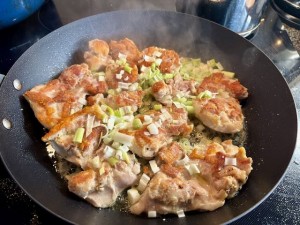
Brown chicken
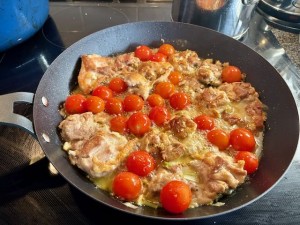
Add tomatoes
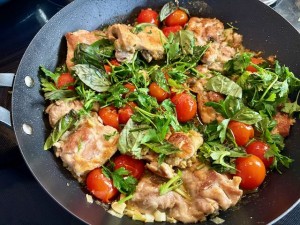
Dijon chicken with tomatoes and scallions
Ingredients:
2 tablespoons (30 ml) olive oil
1 ½ pounds (680 g) boneless, skinless chicken thighs, patted dry
Salt and fresh black pepper
4 scallions, light green and white parts thinly sliced
3 garlic cloves, grated or minced
1 tablespoon (15 ml) dried oregano
1 tablespoon (15 ml) Dijon mustard
½ cup (125 ml) white wine
4 cups (1 L) cherry or grape tomatoes
¼ cup (60 ml) packed cilantro, parsley or basil leaves and tender stems, gently torn or chopped
Preparation:
Heat the oil in a wide pot or deep 12-inch (30-cm) skillet over medium-high until it shimmers. Add the chicken in an even layer and season the top with salt and pepper. Cook, undisturbed, until the chicken is browned and easily releases from the pan, 7 to 9 minutes.
Flip the chicken and add the scallions to the empty spaces in the pot. Season lightly with salt. Let cook until the scallions soften, about 2 minutes. Add the garlic, oregano, mustard and white wine, turning the chicken pieces over and back again to stir everything together, about 1 minute.
Add the tomatoes and season with salt. Cook, stirring occasionally and gently pressing the tomatoes with the back of a wooden spoon, until the tomatoes burst and the chicken is cooked through, 10 to 12 minutes more. Add a few tablespoons of water if it looks dry at any point.
Sprinkle with the cilantro and serve. Serves 4.
From NYT Cooking
Sun 5 Oct 2025
Posted by Recipe Sleuth under New Finds
No Comments
This recipe from NYT Cooking is a keeper. The featured ingredient is chile crisp, a Sichuan-style Chinese condiment made with oil, onion and spices. Cook garlic and the white and light green parts of scallions. Add tomato paste, chile crisp and beans. Sprinkle cheese on top and bake for about 10 minutes. If you want the top to be browner, broil for a few minutes. Cook’s note: I used minced fresh onion instead of dried in the chile crisp.
Avoiding Additives and Preservatives
I haven’t been able to find preservative-free chile crisp, so I made my own. The recipe, also from NYT Cooking, is below. Make sure to check the spices for colour or anti-caking agents. Simple brand tomato paste is free of additives. Blue Menu white beans are free of preservatives. You could also soak and cook a cup of dried white beans. Make sure the cheddar does not contain colour.
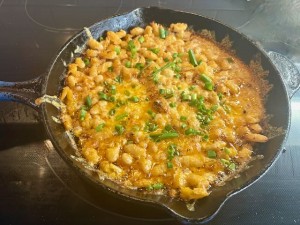
Cheesy chile crisp white beans
Ingredients:
Chile crisp
½ cup (125 ml) vegetable oil
¼ cup (60 ml) dried minced onion
1 teaspoon (5 ml) granulated sugar
1 ½ teaspoons (7.5 ml) kosher salt
1/3 cup (85 ml) finely crushed dried small red chiles or red-pepper flakes
3 tablespoons (45 ml) sesame seeds
1 teaspoon (5 ml) coarsely ground Sichuan peppercorns
Beans
2 tablespoons (30 ml) extra-virgin olive oil
3 fat garlic cloves, thinly sliced
3 scallions, thinly sliced, white and light green parts separated from dark greens
1 tablespoon (15 ml) tomato paste
2 teaspoons to 2 tablespoons (10 ml to 30 ml) chile crisp or chile paste, to taste
2 (15-ounce/425 g) cans white beans, such as cannellini or Great Northern, drained and rinsed
½ teaspoon (2.5 ml) fine sea salt, plus more to taste
8 ounces (227 g) sharp white Cheddar, grated (about 2 cups/500 ml)
Preparation:
Chile crisp
Combine the oil, onion, ½ teaspoon (2.5 ml) sugar and ½ teaspoon (2.5 ml) salt in a small saucepan. Cook over medium heat, stirring occasionally, until the onion becomes evenly golden brown, 3 to 5 minutes.
Add the chiles, sesame seeds and Sichuan peppercorns and sizzle, stirring, for 1 minute, then stir in the remaining ½ teaspoon (2.5 ml) sugar and 1 teaspoon (5 ml) salt. Use immediately or refrigerate in an airtight container for up to 2 weeks. Makes 1¼ cups (310 ml).
Beans
Heat oven to 475 degrees F (246 C). In a 10-inch (25-cm) ovenproof skillet, heat olive oil over medium-high. Add garlic and white and light green scallion slices, reserving the dark greens for later. Cook until lightly golden, 1 to 3 minutes. Carefully stir in tomato paste and chile crisp and cook for 1 minute.
Stir in the beans and salt. Taste mixture, adding more salt and chili crisp as needed (remember that the cheese will add saltiness, so don’t overdo the salt here). Sprinkle cheese evenly over the top. Bake for 6 to 10 minutes, or until the cheese has melted and browned in spots. If you’d like to toast the top further, run the skillet under the broiler for 1 to 2 minutes. Sprinkle with reserved scallion greens and serve. Serves 4.
From NYT Cooking
Sun 28 Sep 2025
Posted by Recipe Sleuth under New Finds
No Comments
This delicious recipe from NYT Cooking flavours chicken with berbere spice, which originated in Ethiopia. Brown the chicken and set aside. Add onion and garlic, spices, stock, orange juice and brown sugar. Return the chicken to the pan and simmer for about 15 minutes or until cooked through.
Avoiding Additives and Preservatives
Make sure the spices don’t contain colour or anti-caking agents. I used Better Than Bouillon for the stock and freshly squeezed orange juice.
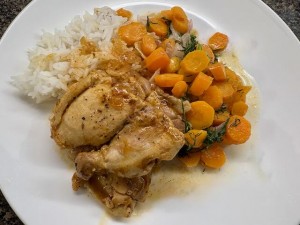
Berbere brown sugar chicken
Ingredients:
Berbere spice mix
8 teaspoons (40 ml) pure chile powder (ground dried red hot peppers) or 2 tablespoons (30 ml) cayenne pepper
5 teaspoons (25 ml) sweet paprika
1 tablespoon (15 ml) salt
1 teaspoon (5 ml) ground coriander
½ teaspoon (2.5 ml) ground ginger
3/8 teaspoon (1.8 ml) ground cardamom
3/8 teaspoon (1.8 ml) ground fenugreek
¼ teaspoon (0.6 ml) ground nutmeg
¼ teaspoon (0.6 ml) ground allspice
1/8 (0.3 ml) teaspoon ground cloves
Chicken
1 ½ pounds (680 g) boneless, skinless chicken thighs
Kosher salt and black pepper
2 tablespoons (30 ml) olive oil or ghee
1 large red onion, finely chopped
4 garlic cloves, thinly sliced
2 tablespoons (30 ml) berbere spice
½ teaspoon (2.5 ml) dried oregano
1 cup (250 ml) chicken broth
1 large orange, juiced (about 1/3 cup/83 ml)
1 tablespoon(15 ml) brown sugar
Cooked rice (optional), for serving
Preparation:
For spice mix, combine all ingredients.
Season both sides of the chicken pieces with salt and pepper. Set aside.
Heat a large skillet over medium-high. Once hot, add the olive oil and place the chicken in the skillet in a single layer. Cook for 4 to 5 minutes, until golden brown on the bottom. Turn the chicken and cook for another 3 minutes. Remove the chicken to a plate and set aside.
Lower the heat to medium. Add the onion and garlic to the same skillet. Cook, stirring occasionally, until softened, about 3 minutes. Add berbere spice and oregano and lightly season with salt. Stir until spices are fragrant, making sure they don’t burn.
Add the chicken broth, scraping up any browned bits from the bottom of the pan. Then add the orange juice and brown sugar, stirring until the sugar dissolves. Adjust the salt to taste, then return the chicken and its juices to the pan, nestling it into the sauce.
Simmer for another 15 minutes, turning the chicken occasionally, until the chicken is tender and cooked through and the sauce has reduced by half. Serve over rice if desired. Serves 4.
From NYT Cooking
Sun 7 Sep 2025
Posted by Recipe Sleuth under New Finds
No Comments
This recipe from NYT Cooking is a good way to use up end-of-season tomatoes. Marinate the steak in Worcestershire sauce, oil, salt and pepper. Combine tomatoes, shallot, capers, brine, Worcestershire sauce and oil and set aside for up to an hour. Grill the steak and serve sliced with the tomato tartare, topped with chives. Cook’s note: I grilled a strip loin instead of a skirt, flank, flatiron or bavette steak and omitted the chives.
Avoiding Additives and Preservatives
Lea & Perrins Worcestershire sauce is free of additives, as are Unico capers.
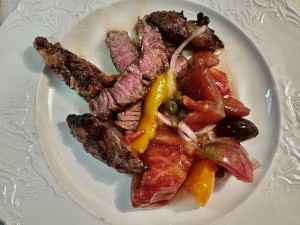
Grilled steak salad with tomato tartare
Ingredients:
2 tablespoons (30 ml) plus ½ teaspoon (2.5 ml) Worcestershire sauce
5 tablespoons (75 ml) extra-virgin olive oil
1 ½ pounds (680 g) skirt, flank, flatiron or bavette steak, patted dry
Salt and black pepper
1 pound (454 g) tomatoes, chopped into bite-size pieces
1 large shallot, thinly sliced and rinsed under cold water
2 tablespoons (30 ml) capers, chopped, plus 1 tablespoon (15 ml) brine
¼ cup (60 ml) thinly sliced chives
Preparation:
Heat the grill to high. In a container that fits the steak, stir together 2 tablespoons (30 ml) Worcestershire and 2 tablespoons (30 ml) oil. Season the steak lightly with salt and generously with pepper, then toss to coat in the marinade. Let sit while you make the tomatoes (or up to 24 hours in the refrigerator).
In a medium bowl, stir together the tomatoes, shallot, capers, brine, remaining ½ teaspoon (2.5 ml) Worcestershire and the remaining 3 tablespoons (45 ml) oil. Season to taste with salt and pepper. Set aside (up to 1 hour ahead).
Shake the marinade off the steak. Grill the steak, flipping every 3 minutes, until well-browned and medium-rare, 6 to 15 minutes, depending on the thickness of the steak. If using a gas grill, cover grill between flips. Transfer to a cutting board to rest for at least 5 minutes.
Slice the steak and top with the tomatoes and all the juices in the bowl, followed by the chives. Serves 4.
From NYT Cooking
Sun 31 Aug 2025
Posted by Recipe Sleuth under New Finds
No Comments
This recipe from NYT Cooking is a quick and easy way to use up end-of-summer tomatoes and basil. Sauté garlic and tomatoes in oil until the tomatoes start to release their juices but are still intact. Add cooked pasta and basil and season with salt and pepper. Serve the pasta topped with sliced prosciutto and dollops of ricotta. Cook’s note: I used cherry tomatoes and feta instead of ricotta.
Avoiding Additives and Preservatives
I used San Danielle prosciutto, which is preserved with salt. Tre Stelle ricotta is free of additives and preservatives.
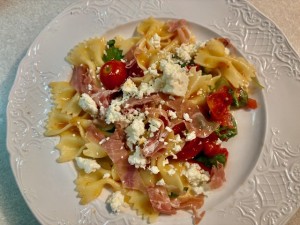
Fresh tomato, basil and prosciutto pasta
Ingredients:
12 ounces (340 g) spaghetti
Salt and pepper
6 garlic cloves
1 ½ pounds (680 g) ripe tomatoes (any variety)
1/3 cup (82.5 ml) olive oil, plus more for drizzling
1 ½ cups (375 ml) fresh basil leaves
3 to 4 ounces (85 to 113 g) thinly sliced prosciutto, preferably at room temperature
½ cup (125 ml) fresh ricotta, preferably at room temperature
Preparation:
Cook pasta according to package instructions in a large pot of salted boiling water until al dente, then drain.
While the pasta is cooking, thinly slice the garlic and cut the tomatoes into large bite-size pieces.
Heat the olive oil in a large skillet or sauté pan over medium. After 2 minutes, add the garlic and let sizzle for about 1 minute without browning, then add the tomatoes and use tongs to toss in the garlic oil. Season with salt and cook, tossing gently, until tomatoes are warmed through and have started to release their juices but are still intact, about 3 minutes. Turn off heat.
Add the pasta to the warm tomatoes, then tear the basil into pieces and toss together with the pasta, tomatoes and garlic. Season with salt and pepper.
To serve, transfer warm pasta onto plates, tear the prosciutto into pieces and drape them over top. Dollop on the ricotta, season with salt and pepper and finish with a drizzle of olive oil. Serves 4.
From NYT Cooking
Sun 3 Aug 2025
Posted by Recipe Sleuth under New Finds
No Comments
This vegetarian dish from NYT Cooking is colourful and delicious. Slice the vegetables and halloumi and toss with oil, salt and pepper. Grill until the vegetables are tender and the halloumi is softened and has grill marks. Serve sprinkled with fresh herbs and sumac, if you are using. Cook’s note: You can make this inside using a ridged grill pan. The vegetables will require more cooking time. I used a regular eggplant and omitted the sumac. I drizzled some vinaigrette on the vegetables before serving.
Avoiding Additives and Preservatives
I used President’s Choice halloumi, which is free of additives. Check the dried spices to make sure they don’t contain colour or anti-caking agents.

Grilled halloumi and vegetables
Ingredients:
¾ pound (340 g) halloumi
2 sweet red peppers
1 large zucchini
1 Japanese eggplant
1 bunch scallions, trimmed
Salt and pepper
About ¼ cup (60 ml) olive oil
2 teaspoons (10 ml) fresh thyme or crumbled dried mint
½ to 1 teaspoon (2.5 to 5 ml) sumac (optional)
Preparation:
Prepare a hot grill. Cut halloumi into 8 to 12 slabs, about ½ inch (1.25 cm) thick. Cut peppers into wide pieces, slicing from top to bottom along the natural indentations. Discard seeds. Cut pieces in half crosswise. Slice the zucchini and eggplant on the diagonal, into ¼-inch (0.6-cm) rounds.
Season all vegetables with salt and pepper. Brush vegetables and halloumi with olive oil.
Grill vegetables until tender and nicely charred, turning occasionally. If you’d like, use an outdoor grill pan to keep them from slipping through the grate. Scallions will be ready after 3 to 4 minutes. Peppers, zucchini and eggplant take about 10 minutes. Arrange on a platter.
Grill halloumi, turning occasionally, for 2 to 6 minutes, until grill marks appear. When you press on the cheese, it should give but it should not be runny.
Remove cheese to the platter with vegetables and drizzle with olive oil. Sprinkle cheese and vegetables with herbs and sumac, if you’d like, and serve. Serves 4.
From NYT Cooking
Sun 20 Jul 2025
Posted by Recipe Sleuth under New Finds
No Comments
This recipe from NYT Cooking is tasty and colourful. Melt butter in pan and add soy sauce, vinegar, ginger and pepper. Top with the fish and steam until it is almost done. Add the peas and continue steaming until the peas are bright green and the fish is fully cooked. Garnish with cilantro before serving.
Avoiding Additives and Preservatives
Use butter that contains only milk or cream with no colour added. Use tamari instead of soy sauce. I used Marukan rice vinegar, which is free of additives.
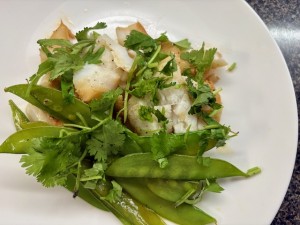
Soy butter fish and peas
Ingredients:
1 ¼ pounds skinless white fish (such as cod, hake or halibut), cut into 4 equal pieces
Salt and freshly ground black pepper
¼ cup (60 ml) unsalted butter
3 tablespoons (45 ml) soy sauce
3 tablespoons (45 ml) unseasoned rice vinegar
1 (2-inch/5-cm) piece (unpeeled) ginger, thinly sliced into rounds
3 cups (750 ml) snow peas or snap peas (or a mix)
1 cup (250 ml) coarsely chopped cilantro
Preparation:
Season the fish on all sides with salt and set aside.
Melt the butter in a large, deep skillet over medium-high heat. Once the butter is melted, stir in the soy sauce, vinegar and ginger. Season with about 6 cranks of pepper (or ½ teaspoon/2.5 ml, if you’re measuring).
Using tongs, gently lay the pieces of fish in the pan. Cover the skillet and steam until the fish is almost fully opaque, 3 to 5 minutes.
Uncover and sprinkle the snow peas over the fish. Cover the skillet again and continue to steam until the fish is fully opaque and cooked through and the peas are bright green, 1 to 2 minutes.
Garnish with cilantro and serve directly from the pan or transfer to a platter. Serves 4.
From NYT Cooking
Sun 13 Jul 2025
Posted by Recipe Sleuth under New Finds
No Comments
This recipe from NYT Cooking is quick, easy and so tasty. Cook cherry tomatoes in butter and oil for a few minutes. Add garlic, shallot, salt, pepper and hot pepper flakes and cook for a few minutes more. Meanwhile, cook the pasta and drain it. Add the cooked pasta, herbs and some pasta water to the tomato mixture and heat through. Serve topped with Parmesan. Cook’s note: I used spaghettini for the pasta.
Avoiding Additives and Preservatives
Use butter that contains only milk or cream, with no colour added. Check the dried spices to make sure they don’t contain colour or anti-caking agents. Genuine Parmesan is free of additives; check for the name on the rind.

Angel hair pasta
Ingredients:
Salt
¼ cup (60 ml) extra-virgin olive oil
3 tablespoons (45 ml) butter
1 pound (454 g) cherry tomatoes, halved
3 garlic cloves, minced
1 shallot, minced
Freshly ground black pepper
Crushed red pepper (optional)
1 pound (454 g) angel hair pasta
2 tablespoons (30 ml) minced fresh parsley or 2 teaspoons (10 ml) dried parsley
2 tablespoons (30 ml) minced fresh basil or 2 teaspoons (10 ml) dried basil
Freshly grated Parmesan, for serving
Preparation:
Heat a large pasta pot of salted water to a boil.
To a large pan over medium heat, add olive oil and butter. Allow the butter to melt, then add cherry tomatoes. Cook until tomatoes are beginning to soften and the skins are a little blistered, 4 to 6 minutes.
Add garlic, shallot, 1 teaspoon (5 ml) each of kosher salt and black pepper, and a pinch of red pepper, if using, and toss to combine with the tomatoes. Cook for about 6 minutes, until the shallots are translucent and the tomatoes are fully softened yet still intact. Meanwhile, add pasta to the boiling salted water and cook until al dente according to the packaging directions, about 2 minutes. Reserve 1 cup (250 ml) of pasta water, then strain the pasta.
Add the cooked pasta, herbs and a bit of the reserved pasta water to the pan and cook for 2 minutes, stirring to combine, until you have a glossy pasta sauce; add more pasta water slowly, if needed. Serve topped with plenty of Parmesan. Serves 4.
From NYT Cooking
Sun 6 Jul 2025
Posted by Recipe Sleuth under New Finds
No Comments
This recipe from NYT Cooking is an easy weeknight dinner. Marinate chicken thighs in mayonnaise, basil, garlic and pickled jalapeno brine. While the oven is preheating, toss together corn, pickled jalapenos, olive oil, salt and scallions. Roast the chicken on a sheet pan for about 12 minutes, then add the corn mixture. Roast for another 15 minutes or so, or until the chicken is cooked. Broil for a few minutes until the chicken and corn turn brown in places. Serve garnished with scallions, jalapenos, jalapeno brine and lime juice.
Avoiding Additives and Preservatives
I used Hellmann’s mayonnaise, Green Giant frozen corn and La Costena pickled jalapeno slices. All are additive-free.

Sheet-pan chicken thighs with spicy corn
Ingredients:
2 pounds (900 g) boneless, skinless chicken thighs
1 ¾ teaspoons (8.75 ml) fine sea or table salt
2 tablespoons (30 ml) mayonnaise
¼ cup (60 ml) finely chopped basil, plus more for garnish
2 garlic cloves, finely grated or minced
1/3 cup (82.5 ml) chopped pickled jalapeños, plus brine from the jar
4 cups (1 L) fresh or frozen corn kernels (from about 4 ears)
3 tablespoons (45 ml) olive oil, plus more for drizzling
5 scallions, thinly sliced
1 jalapeño, sliced into rings
1 lime, halved
Preparation:
Season the chicken all over with ¾ teaspoon (3.75 ml) of salt. In a large bowl, stir together the mayonnaise, basil, garlic and 2 tablespoons (30 ml) jalapeño brine. Add the chicken to the marinade. Cover and refrigerate for 30 minutes and up to 6 hours.
Heat oven to 425 degrees F (218 degrees C). In a medium bowl, toss together corn, pickled jalapeños, olive oil, remaining 1 teaspoon (5 ml) salt and half of the scallions (save remaining scallions for serving).
Arrange the chicken on a baking sheet, spacing it out. Roast for 12 minutes. Spoon the corn mixture onto the empty parts of the baking sheet. Drizzle chicken and corn with oil. Continue to roast until the chicken is cooked through, 10 to 15 minutes longer, stirring the corn once while roasting.
Turn the broiler on high and broil the chicken and corn until golden brown in spots, 2 to 4 minutes (watch carefully so it doesn’t burn, though a little blistering is nice).
Garnish chicken and corn with basil, remaining scallions and fresh jalapeño slices. Sprinkle with more pickled jalapeño brine and squeeze with lime juice. Serve hot or at room temperature. Serves 4-6.
From NYT Cooking
Sun 22 Jun 2025
Posted by Recipe Sleuth under New Finds
No Comments
This tasty recipe from NYT Cooking tosses shredded cabbage with a citrus dressing and tops it with succulent grilled shrimp. Marinate the shrimp briefly in some of the dressing before grilling. Reserve more dressing and toss cabbage, mango, cilantro and scallions with the remaining dressing. Transfer to the slaw to a serving platter and top with shrimp. Drizzle the remaining dressing on top. Cook’s note: I omitted the mango.
Avoiding Additives and Preservatives
Use freshly squeezed orange and lime juice, pure honey and shrimp that has been preserved with salt.

Grilled shrimp with spicy slaw
Ingredients:
¼ cup (60 ml) freshly squeezed orange juice (from 1 orange)
3 tablespoons (45 ml) freshly squeezed lime juice (from 2 limes)
¼ cup (60 ml) neutral oil
2 tablespoons (30 ml) honey
2 tablespoons (30 ml) thinly sliced jalapeño (or more, to taste)
½ teaspoon (2.5 ml) kosher salt
1 pound (454 g) large (16 to 20 count) peeled and deveined shrimp
4 packed cups (1 L) thinly shredded green cabbage
1 mango (optional), peeled and julienned
1 cup (250 ml) chopped cilantro
2 thinly sliced scallions
Preparation:
Make the dressing: In a large bowl, whisk together the orange juice, lime juice, oil, honey, jalapeño and salt. Taste and add more jalapeño if you’d like more heat.
Add 2 tablespoons (30 ml) of the dressing to a medium bowl and toss with the shrimp; let the shrimp marinate while you heat a grill or grill pan over medium-high.
Reserve 2 tablespoons (30 ml) f the dressing from the large bowl, then add the cabbage, mango (if using), cilantro and scallions to the large bowl; toss to coat.
Grill the shrimp until lightly charred and cooked through, about 3 minutes per side.
Transfer the slaw to a serving platter. Set the shrimp on top and drizzle shrimp with the remaining 2 tablespoons (30 ml) of dressing; serve immediately. Serves 4.
From NYT Cooking











